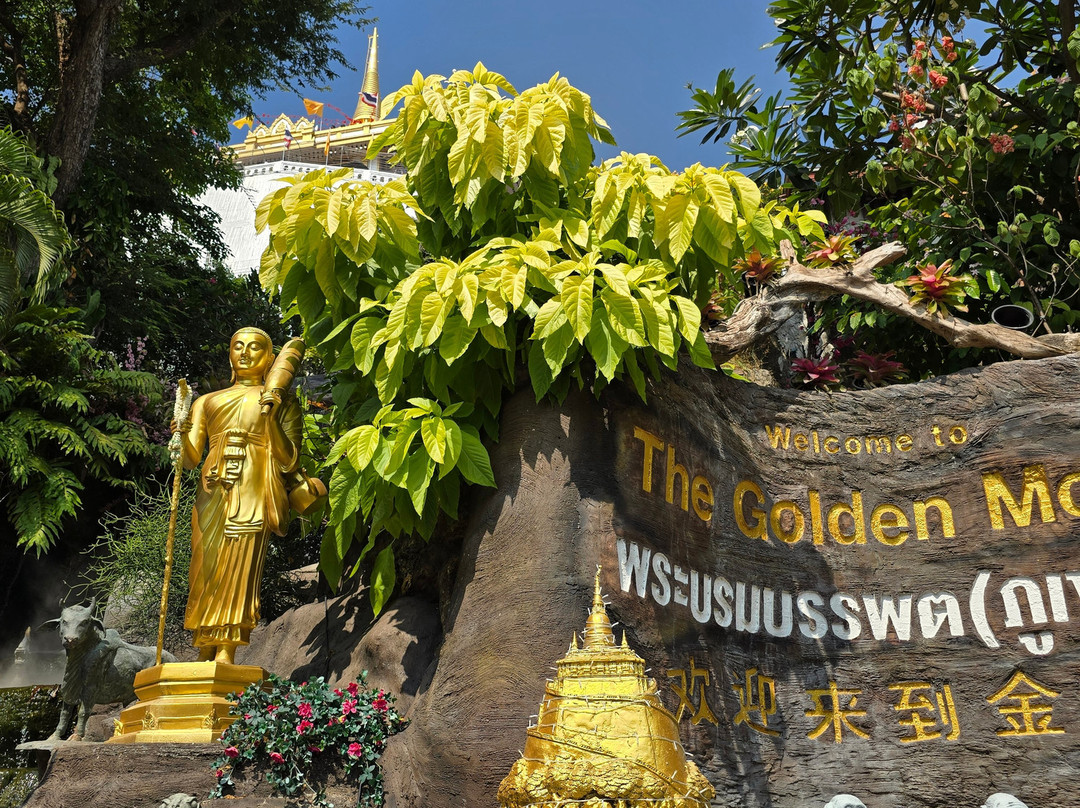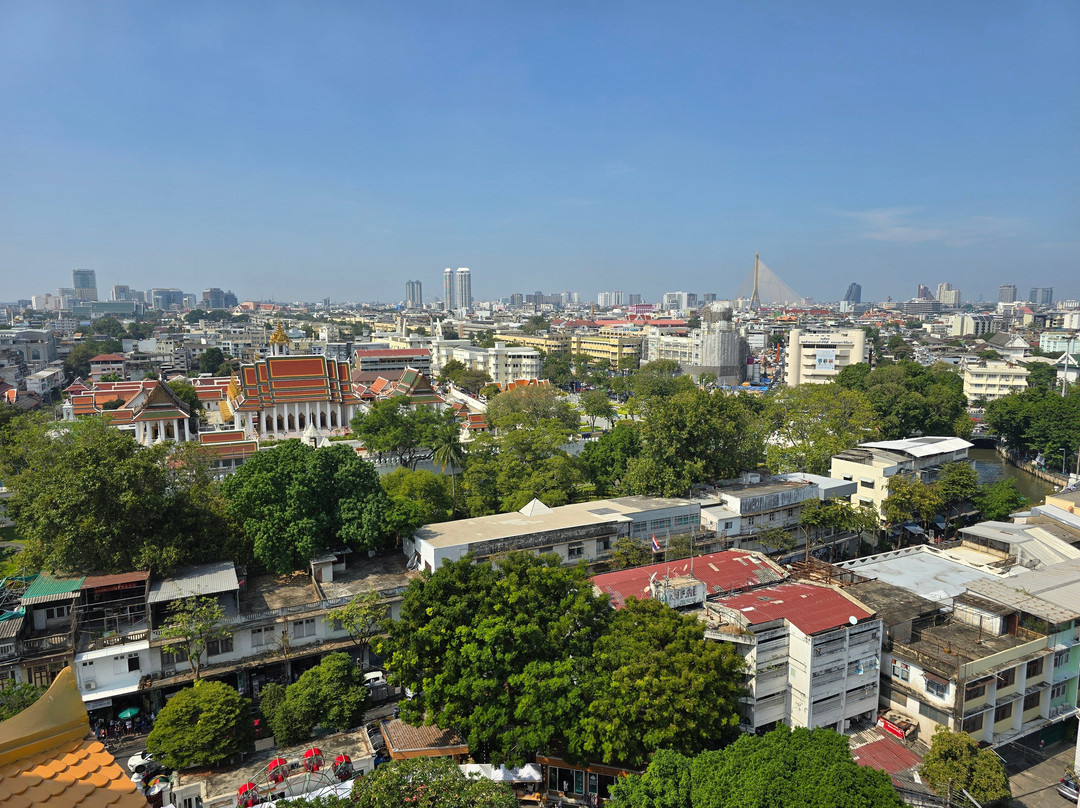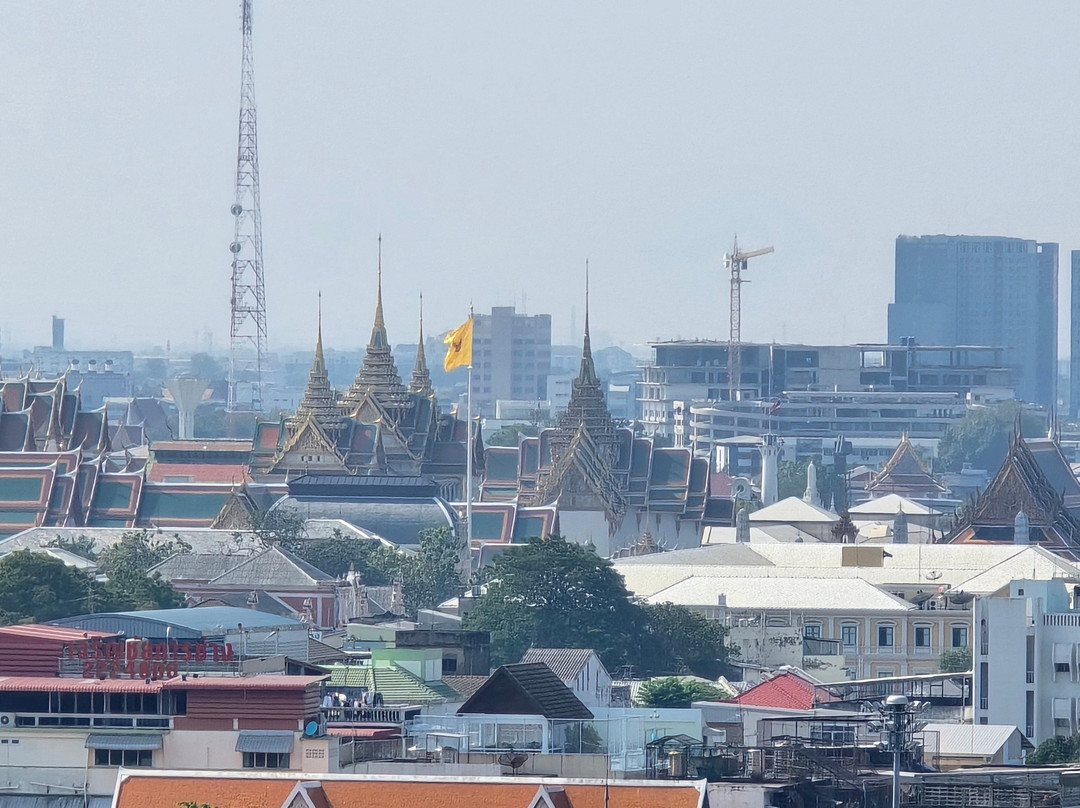的点评
Nice Temple on top the only hill in Bangkok
金山寺的点评
点评:Bangkok is 100% flat city with no hills around, so you might wonder where this one came from???
King Rama III decided to make an artificial hill in the center of the city in order to build a huge Pagoda on top of it in early 19c. Unfortunately, the Pagoda collapsed during the construction due to soft soil. That ruined brick Pagoda along with mud and soil brought beforehand, made a stronger surface and higher elevation for King Rama IV to continue the building work of his predecessor. However, he didn't live enough to finish it, but his son Rama V succeeded at the end of 19c. He also brought a Buddha relic from Sri Lanka placing it in the Pagoda.
Over the century Wat Saket became one of important Bangkok Temples attracting millions both, locals and tourists. Entry is through the gate of surrounding walls which were built in mid 20c in order to prevent the artificial hill from erosion.
Within the walls before starting your ascend to the Temple the atmosphere is fair like. Hundreds of food stalls, fortune tellers, wish trees and pools, souvenirs, monks,....
Entry fee is 100 Baht - 3$, and the path leads you through artificial rainforest with streams and steam rising from rocks (little bit kitschy). To the top are around 320 steps, though pretty easy. Once up, there's a Temple, Buddha relic and great 360' views of the city.
King Rama III decided to make an artificial hill in the center of the city in order to build a huge Pagoda on top of it in early 19c. Unfortunately, the Pagoda collapsed during the construction due to soft soil. That ruined brick Pagoda along with mud and soil brought beforehand, made a stronger surface and higher elevation for King Rama IV to continue the building work of his predecessor. However, he didn't live enough to finish it, but his son Rama V succeeded at the end of 19c. He also brought a Buddha relic from Sri Lanka placing it in the Pagoda.
Over the century Wat Saket became one of important Bangkok Temples attracting millions both, locals and tourists. Entry is through the gate of surrounding walls which were built in mid 20c in order to prevent the artificial hill from erosion.
Within the walls before starting your ascend to the Temple the atmosphere is fair like. Hundreds of food stalls, fortune tellers, wish trees and pools, souvenirs, monks,....
Entry fee is 100 Baht - 3$, and the path leads you through artificial rainforest with streams and steam rising from rocks (little bit kitschy). To the top are around 320 steps, though pretty easy. Once up, there's a Temple, Buddha relic and great 360' views of the city.
翻译:曼谷是一座 100% 平坦的城市,周围没有山丘,所以您可能想知道这座山丘从何而来???
19 世纪初,拉玛三世国王决定在市中心建造一座人造山丘,以便在其上建造一座巨大的宝塔。不幸的是,由于土壤松软,宝塔在建造过程中倒塌。这座破损的砖塔以及之前带来的泥土为拉玛四世国王提供了更坚固的表面和更高的海拔,以便继续其前任的建筑工作。然而,他没能活到完成它,但他的儿子拉玛五世在 19 世纪末继承了王位。他还从斯里兰卡带来了佛陀舍利,将其放在宝塔中。
一个世纪以来,金山寺成为曼谷重要的寺庙之一,吸引了数百万当地人和游客。入口是通过周围墙壁的大门,这些墙壁建于 20 世纪中期,以防止人造山丘受到侵蚀。
在您开始攀登寺庙之前,墙壁内的气氛是晴朗的。数以百计的小吃摊、算命师、许愿树和水池、纪念品、僧侣……
入场费为 100 泰铢 - 3 美元,小路会带您穿过人工雨林,溪流和从岩石中升起的蒸汽(有点俗气)。到山顶大约有 320 个台阶,但相当容易。一旦上去,就会看到一座寺庙、佛像遗物和 360 度的城市美景。
19 世纪初,拉玛三世国王决定在市中心建造一座人造山丘,以便在其上建造一座巨大的宝塔。不幸的是,由于土壤松软,宝塔在建造过程中倒塌。这座破损的砖塔以及之前带来的泥土为拉玛四世国王提供了更坚固的表面和更高的海拔,以便继续其前任的建筑工作。然而,他没能活到完成它,但他的儿子拉玛五世在 19 世纪末继承了王位。他还从斯里兰卡带来了佛陀舍利,将其放在宝塔中。
一个世纪以来,金山寺成为曼谷重要的寺庙之一,吸引了数百万当地人和游客。入口是通过周围墙壁的大门,这些墙壁建于 20 世纪中期,以防止人造山丘受到侵蚀。
在您开始攀登寺庙之前,墙壁内的气氛是晴朗的。数以百计的小吃摊、算命师、许愿树和水池、纪念品、僧侣……
入场费为 100 泰铢 - 3 美元,小路会带您穿过人工雨林,溪流和从岩石中升起的蒸汽(有点俗气)。到山顶大约有 320 个台阶,但相当容易。一旦上去,就会看到一座寺庙、佛像遗物和 360 度的城市美景。


















此点评仅代表旅行者个人的主观意见,并不代表TripAdvisor以及其合作方的意见。
关于我们
|新闻动态
|商务合作
|会员中心
|业主中心
|常见问题
|意见反馈
|联系我们
|营业执照
© 2025 Tripadvisor 版权所有。
使用条款 |隐私政策 |网站工作原理
部分照片由 VFM Leonardo 提供。
* Tripadvisor不是旅行社,也不是旅游预订服务代理商。我们提供免费、客观、公正的旅游资讯服务。 (显示更多)
TripAdvisor LLC 既不是预订代理商,也不是旅游运营商,不会向网站用户收取任何服务费。 按照规定,在 Tripadvisor 发布机票价格、游览和旅行套餐的合作伙伴(航空公司、旅行提供商及预订代理商),其标价须包含所有费用和附加费用。 例如, 机场出入境税费、消费税与其他服务费、手续费、杂费及附加费用。 当您向我们的某个合作伙伴进行预订时,请务必查阅他们的网站以了解当地行政部门要求的所有适用费用的具体情况。 除非另有说明,机票价格通常指的是一个人的价格(以人民币计)。
为方便起见,TripAdvisor LLC 根据从我们的预订合作伙伴获取的空房率计算每个酒店的均价。 对于游览和景点来说,所显示价格通常是每位成人的最低可用价格。 对于列出的任何旅行套餐或优惠,TripAdvisor LLC 无法保证任何特定的费率或价格。 此外,酒店均价每晚会更新,并以您的首选币种表示(使用现行汇率)。 由于这些已换算的价格是预估价格,因此,有关具体金额和币种请与预订网站进行核实。
此外,TripAdvisor LLC 无法保证我们网站上宣传的价格随时有效。 标价可能需要预订一定天数才能生效,或有不可用日期、使用条件或限制。
TripAdvisor公司对外部网站的内容一概不负责。优惠价格中不含税和其他费用。
ICP证:沪B2-20200433
沪ICP备20013175号
 沪公网安备31010502005427号
沪公网安备31010502005427号鹰程信息技术(上海)有限公司
货币/国家及地区
¥CNY
中国

